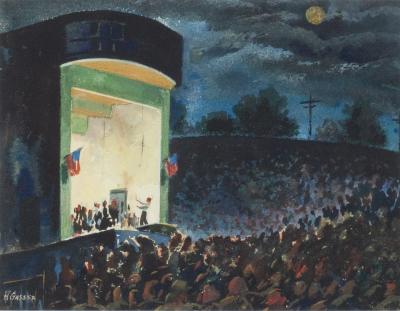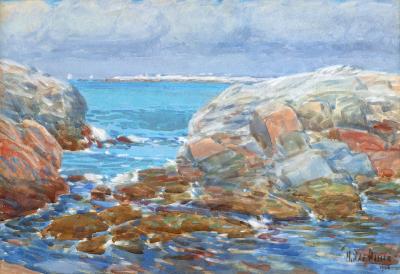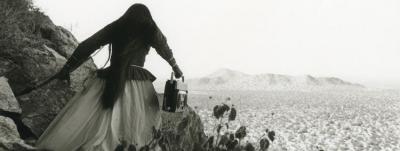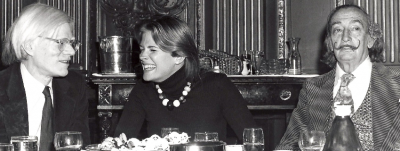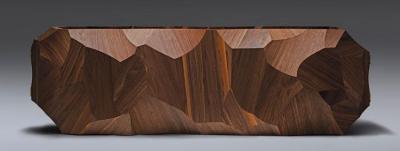J.M.W. Turner: Watercolors from Tate
We often think we know all there is to know about J.M.W. Turner (1775–1851), the English Romantic painter. Masterworks at The Met, the Clark, the Getty, and the National Gallery, all serve to remind us of Turner’s magisterial ability in oils, and to reinforce our view of him as a fully formed artist, a visionary ahead of his time, even a man on edge (famously denied patronage by Queen Victoria who thought him ‘mad, dirty, and dangerous’), and a sort of proto-Pollock for the nineteenth century. Nothing makes this final impression more impactful than Mike Leigh’s 2014 film, Mr. Turner, as actor Timothy Spall spits and scratches at his canvas, all the while reminding us that great artists needn’t also be great human beings.
Missing from this picture are the realities of a complex individual; a man who succeeded beyond any reasonable expectations of his age—through talent, yes, but also dogged work, experimentation, failure, and above all, through a single-minded desire to create a visual archive of the wanderer’s experience in a moment of extraordinary transition. To find these qualities in Turner, we need to look beyond the obvious and to embrace his watercolors. Turner’s dexterity in watercolor defined what was achievable within the simple ingredients of water, paper, and pigment not long after interest in this art form took hold.
Turner’s watercolors are not as easy to find as his oils—not because they are scarce—more than twenty thousand sheets of works on paper make up the foundation of the Turner Bequest held at Tate—but because they are so delicate. Watercolor is an inherently fugitive medium, easily damaged by exposure to light.
This is what makes J.M.W. Turner: Watercolors from Tate, the exhibition at Mystic Seaport Museum in Connecticut, in partnership with Tate, London, so momentous. Curated by David Blayney Brown, Tate’s Manton Senior Curator of British Art 1790-1850, nearly one hundred watercolors (along with a handful of significant oils and a sketchbook), trace the entirety of Turner’s career, from the 1790s to the 1840s, revealing the artist’s relentless investigation of his surroundings, in a format often reserved for his own eyes. On display through February 2020, it is the largest number of watercolors from the Turner Bequest ever to visit this continent, marking an opportunity for pilgrimage, to commune with some of the most coveted artworks in the Western Canon.
 |
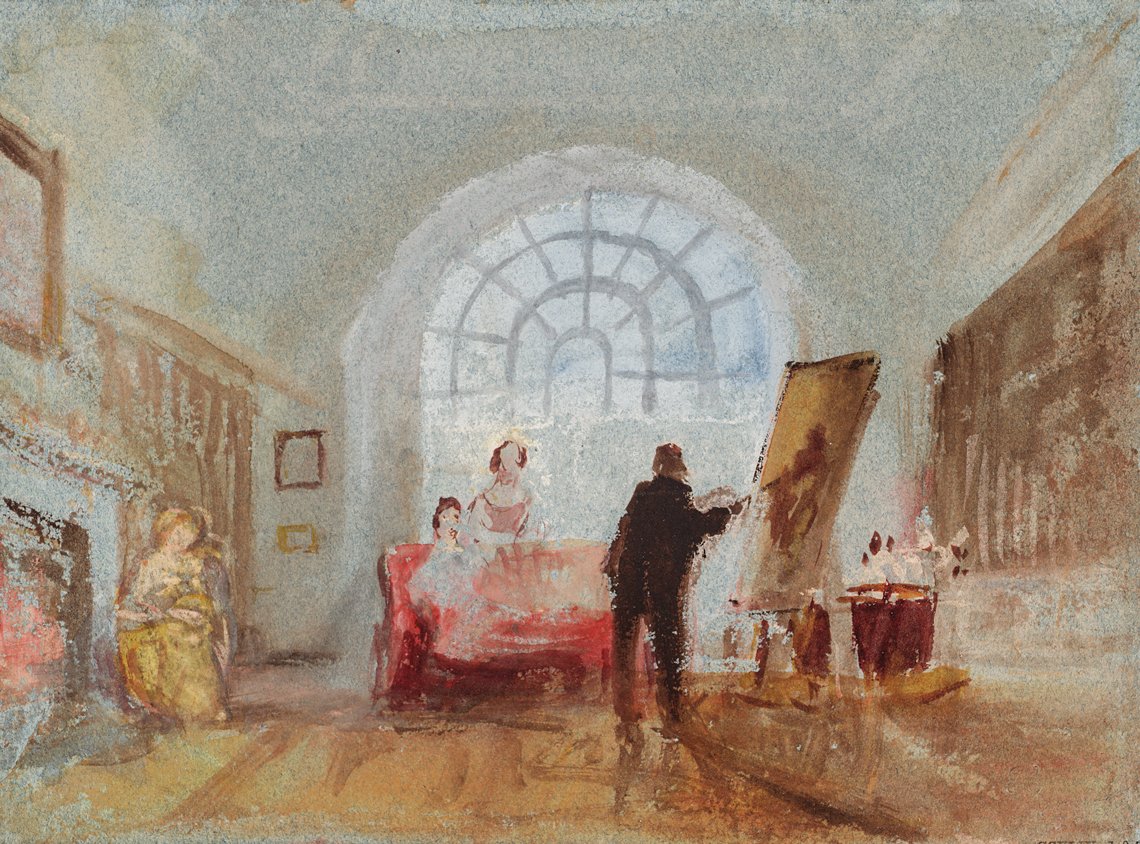 |
J.M.W. Turner (1775–1851), The Artist and his Admirers, 1827. Watercolor and bodycolor on paper, 138 x 190 mm. Tate: Accepted by the nation as part of the Turner Bequest 1856 © Tate, 2019. |
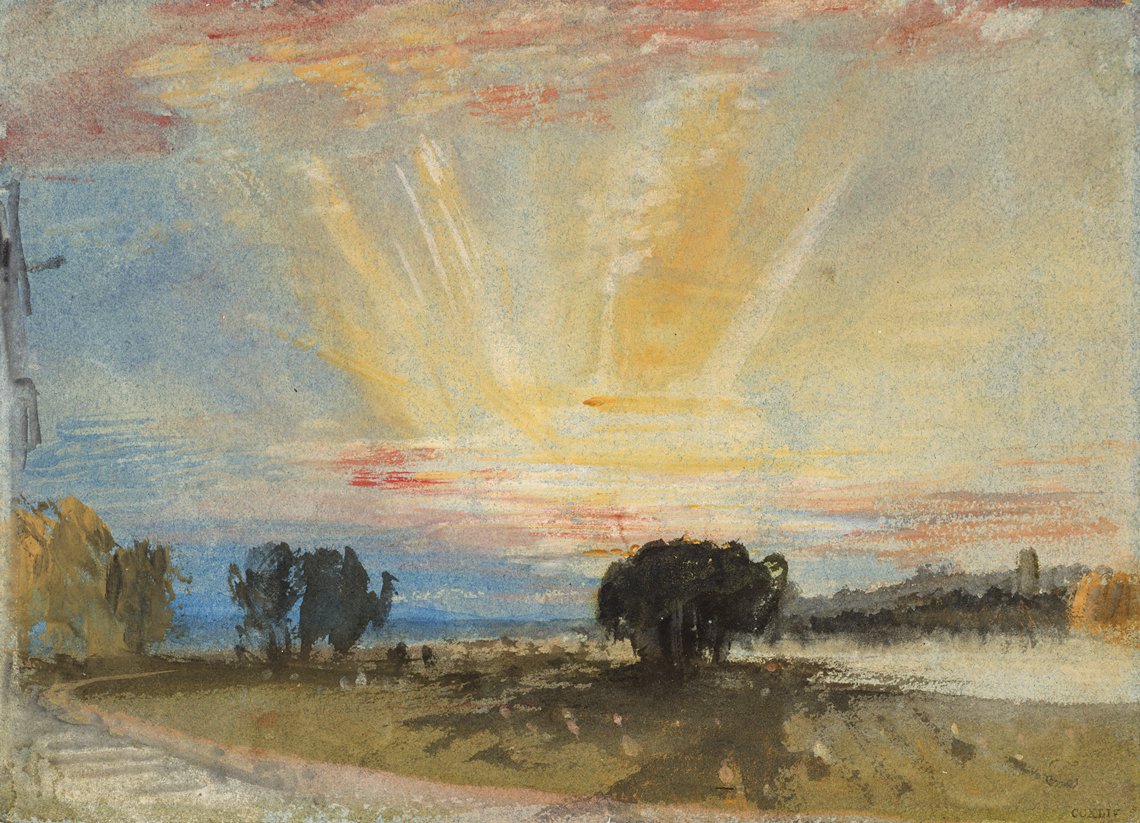 |
J.M.W. Turner (1775–1851), Sunset across the Park from the Terrace of Petworth House, 1827. Gouache and watercolor on paper, 140 x 193 mm. Tate: Accepted by the nation as part of the Turner Bequest 1856 © Tate, 2019. |
These two works together perfectly encapsulate Turner’s unique place in British art in the early nineteenth century. He was a barber’s son from Covent Garden, born without privilege—and yet his talents gave him access to the elite in British society. These are two of more than one hundred quick watercolor and gouache sketches Turner made on blue paper while visiting his friend and client, the third Earl of Egremont at Petworth House in Sussex in summer 1827. Never intended for public display, if anything, they are a private souvenir of Turner’s visit that could be employed as aides memoire for later work, or simply to recall a happy moment. We assume Turner is the artist being admired, but we don’t know for sure.
 |
 |
J.M.W. Turner (1775–1851), Funeral of Sir Thomas Lawrence: A Sketch from Memory. Exhibited 1830. Watercolor and bodycolor on paper, 561 x 769 mm. Tate: Accepted by the nation as part of the Turner Bequest 1856 © Tate, 2019. |
This is an unusual work for Turner, as well as a large work for a watercolor. It depicts the funeral of Turner’s dear friend, Sir Thomas Lawrence, president of the Royal Academy, the institution to which Turner was most loyal as an artist, and where he served as Professor of Perspective for many years. A few things are notable here: the dark palette contrasts with much of Turner’s later work in watercolor; the people are not well drawn—a constant observation of Turner’s art in his own time (today’s critics aren’t much kinder); and the prominence of the man in red coat arriving at the funeral. This is believed to be the Duke of Wellington, prime minister at that time, who did not in fact attend the funeral. Is Turner correcting a faux pas? Twenty-one years after Lawrence’s funeral, Turner would also be buried in the crypt at St. Paul’s. This was the last watercolor Turner exhibited at the Royal Academy in his lifetime.
 |
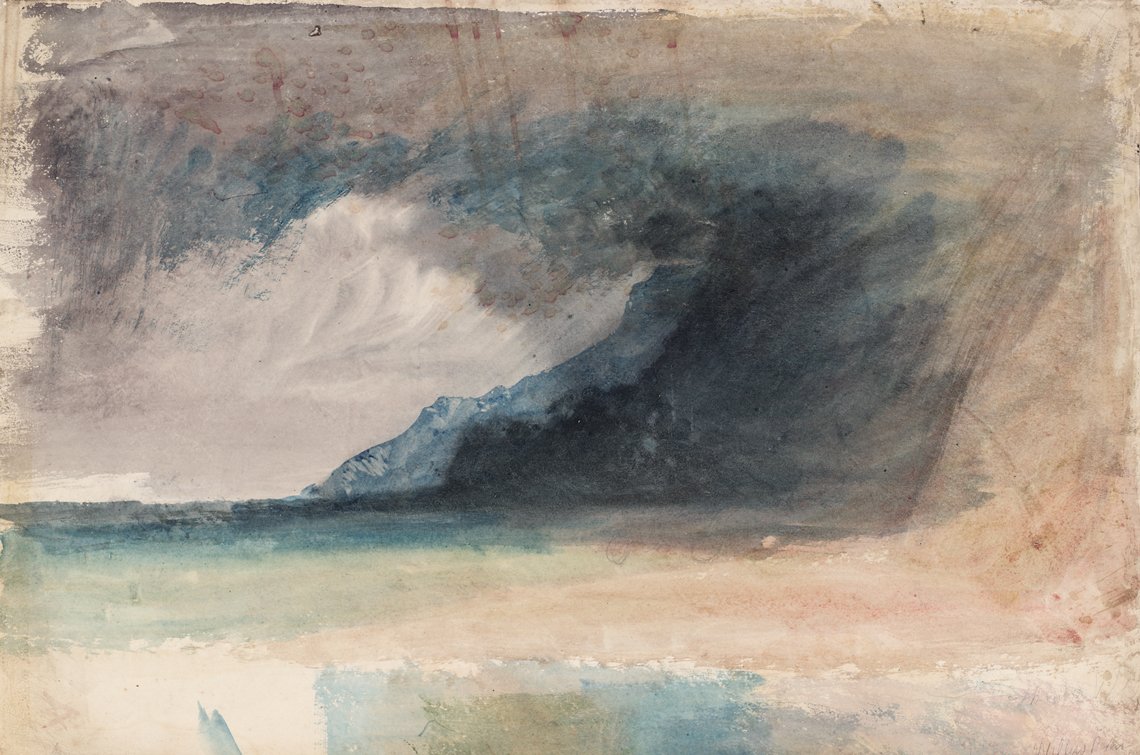 |
J.M.W. Turner (1775–1851), A Mountainous Coast with a Stranded Vessel, or Whale, Possibly at Penmaenmawr or in North-East England, ca. 1825–1838. Graphite and watercolor on paper, 371 x 551 mm. Tate: Accepted by the nation as part of the Turner Bequest 1856 © Tate, 2019. |
This work encapsulates the astonishing value of the Turner Bequest as an archive into Turner’s practice. The raw elements of the storm barrel out of the page, engulfing the viewer. You can see Turner working through different techniques to bring this scene to life. At the same time, it is an exercise in private experimentation, never intended to be seen as a finished work. It’s a perfect example of why Turner’s art has appealed to mariners since he first tackled seascapes in his precocious youth.
 |
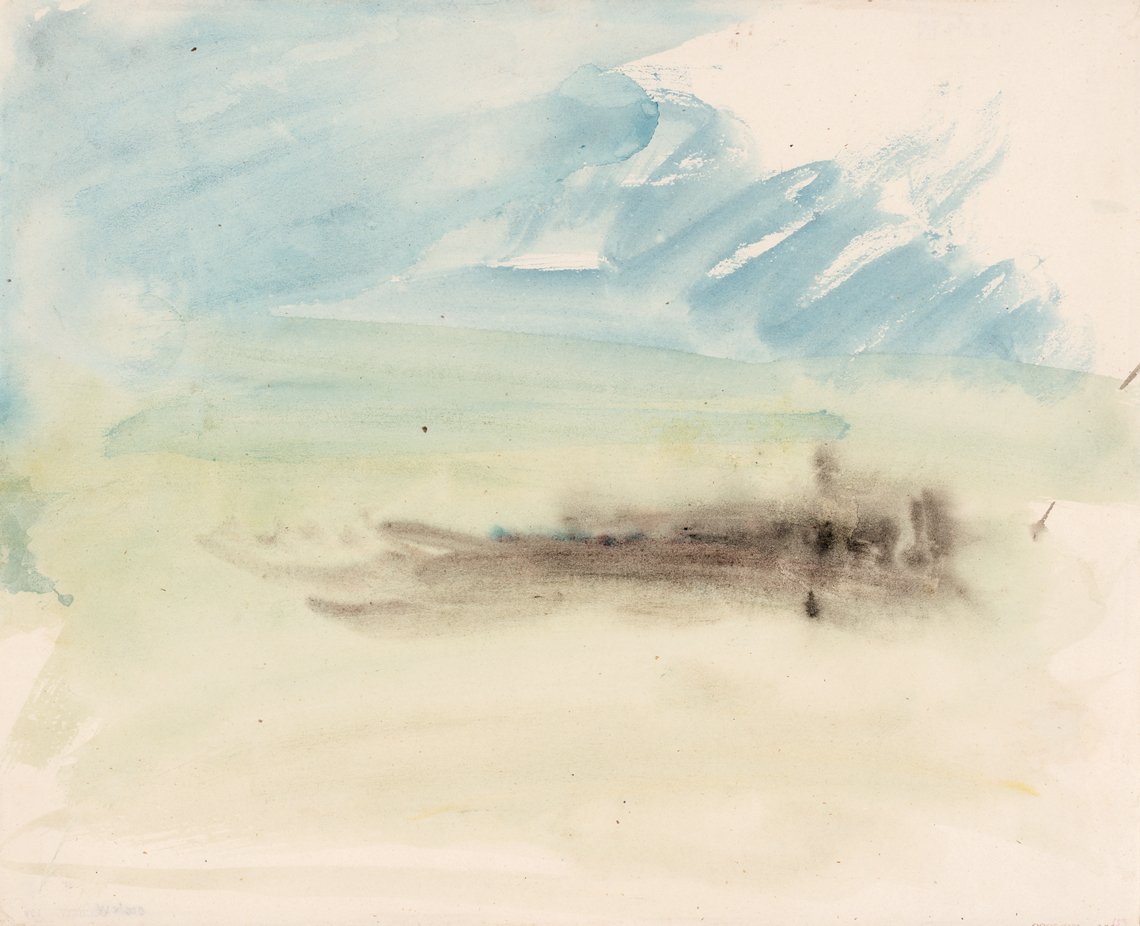 |
J.M.W. Turner (1775–1851), Coastal Terrain, ca. 1830–1845. Watercolor on paper, 221 x 271 mm. Tate: Accepted by the nation as part of the Turner Bequest 1856 © Tate, 2019. |
This is a prime example of what are called Turner’s “color beginnings”—loose sketches meant to capture the palette of a particular lived moment. It’s very tempting to feed these beginnings into a narrative establishing Turner as a father of abstraction in Western art. However, Turner would never have considered abstraction a goal of his work. If anything, such rapid sketches reveal his consummate ability to translate any scene into pure color as a step toward more compelling representational work.
 |
 |
J.M.W. Turner (1775–1851), A Harpooned Whale, 1845. Graphite and watercolor on paper, 238 x 336 mm. Tate: Accepted by the nation as part of the Turner Bequest 1856 © Tate, 2019. |
 |
J.M.W. Turner (1775–1851), Whalers (Boiling Blubber) Entangled in Flaw Ice, Endeavoring to Extricate Themselves, exhibited 1846. Oil paint on canvas, 899 x 1200 mm, frame: 1288 x 1593 x 160 mm. Tate: Accepted by the nation as part of the Turner Bequest 1856 © Tate, 2019. |
The watercolor is from a sketchbook of the early 1840s, and may document a rare occasion when a whale was spotted in the Thames estuary. The violence of the moment is made clear with the dramatic red gash of paint across the whale’s body. Turner has scrawled in pencil, “I shall use this.”
The other work is the fourth and final oil painting in Turner’s whaling series, created 1844–1846, perhaps to entice the whaling magnate Elhanan Bicknell (who only purchased one of the series, now at the Metropolitan Museum of Art). In this scene two whale ships process their kill, while also threatened by sea ice. Both works relate closely to Mystic Seaport Museum’s history of engaging closely with the history of whaling. The museum’s iconic vessel, the Charles W. Morgan (the oldest commercial vessel afloat in the world) was searching for whales in the Pacific on her second voyage when this painting was exhibited in 1846.
 |
 |
J.M.W. Turner (1775–1851), Venice: Looking across the Lagoon at Sunset, 1840. Watercolor on paper, 244 x 304 mm. Tate: Accepted by the nation as part of the Turner Bequest 1856 © Tate, 2019. |
It is easy for us to forget today how rarified long distance travel could be in the early nineteenth century—both due to the lack of transport systems and the Napoleonic Wars, which largely kept Turner from visiting the Continent and Italy until he was middle aged. This ravishing color study of the Lagoon comes from Turner’s final visit to the city that profoundly impacted his art from the time of his first visit in 1819, through the rest of his life.
 |
 |
J.M.W. Turner (1775–1851), Whitby, ca. 1824. Watercolor on paper, 158 x 225 mm. Tate: Accepted by the nation as part of the Turner Bequest 1856 © Tate, 2019. |
This watercolor is clearly more finished than many in the Turner Bequest. This is because it was always intended for display—not as a watercolor, however, but instead via an engraving made from this original. Turner’s engravings of the coasts of England fundamentally shaped how Britons in the 1820s and 1830s viewed their homeland. Astonishing is how many people would have developed this view strictly through Turner’s engraving series—and thus in black and white, without the rich colors on display here.
 |
 |
J.M.W. Turner (1775–1851), View of Fonthill Abbey, ca. 1799–1800. Graphite and watercolor on paper, 1055 x 711 mm. Tate: Accepted by the nation as part of the Turner Bequest 1856 © Tate, 2019. |
This misty view of Fonthill Abbey in Wiltshire, England, confirms Turner’s preternatural talents in watercolor early in his life, even though this work wasn’t completed. The techniques on view here, somehow folding England’s moist climate onto the page, are clearly advanced beyond conventions for the medium at this moment in British art. This is what would have been called an “exhibition watercolor,” meaning it was intended to be shown at the Royal Academy, alongside and in competition with oil paintings. This largely accounts for its more subdued palette, matching the somber works in the more senior medium. Turner’s experimentation with bright color developed steadily over his mature career, so that works like the Venice lagoon pictured here bear little resemblance to this early watercolor.
 |
 |
J.M.W. Turner (1775–1851), Storm over the Mountains, ca. 1842–1843. Graphite, watercolor and pen and ink on paper, 228 x 291 mm. Tate: Accepted by the nation as part of the Turner Bequest 1856 © Tate, 2019. |
Late in life, Turner travelled to Europe nearly every summer, determinedly moving across France, Germany, and Switzerland in search of subjects to inspire new artworks for his public. Among the most coveted of these late watercolors are his views of the Swiss Alps, which seem to serve as the perfect stage for the shifts in weather so central to his romantic view of nature. These were the works most cherished by art critic John Ruskin (1819–1900), when he catalogued the veritable mountain of paper reclaimed from Turner’s studio in the 1850s, and remain favorites today. At time of writing a watercolor of the Rigi Mountain near Lucerne was barred from export from the UK, in the hopes a British museum could secure the means to keep it in country. Such politics in art are a reminder of how significant a loan like this one from Tate are for an American audience.
 |
Mystic Seaport Museum in Mystic, Connecticut, will be the only North American venue for the exhibition. J. M. W. Turner: Watercolors from the Tate is on view through February 23, 2020. For information, visit mysticseaport.org or call 860.572.0711.
Nicholas R. Bell is President and CEO of the Glenbow Museum in Calgary, Alberta. He wrote this article while still senior vice president for curatorial affairs at Mystic Seaport Museum.
This article was originally published in the Winter 2019 issue of Antiques & Fine Art magazine, a fully digitized version of which is available at www.afamag.com. AFA is affiliated with Incollect.com.















